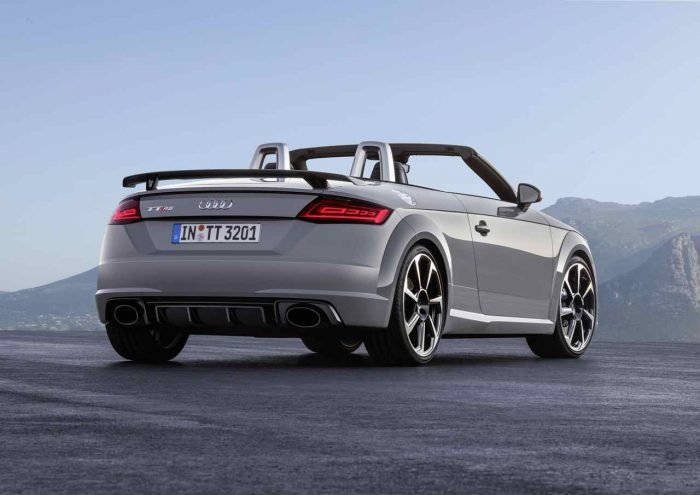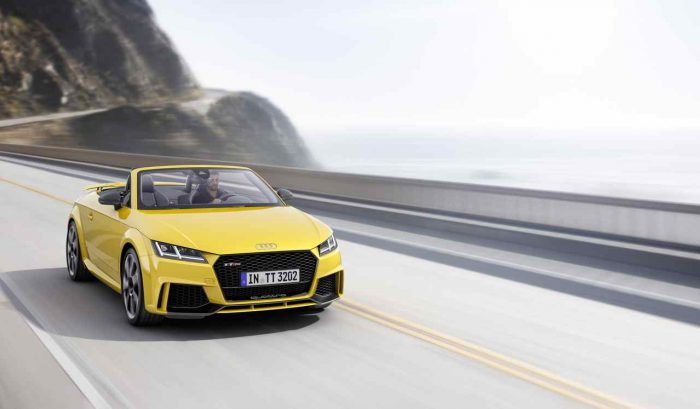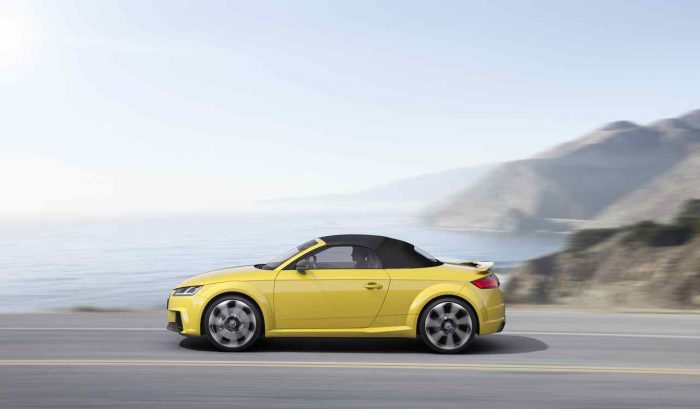Audi TT RS Roadster 2016: 400 CV al viento
Hace unas semanas te hablábamos del nuevo Audi TT RS 2016, con un motor de cinco cilindros en línea que desarrolla 400 CV de potencia. Junto a él, se presentaba también su variante descapotable, el Audi TT RS Roadster, con idéntica mecánica que será la variante más potente del Audi TT Roadster 2015. Está disponible por 82.910 euros, una cifra bastante alta y que supone un sobrecoste de 3.010 euros más que el coupé.

Esta transmisión dispone de un sistema launch control para mejorar la aceleración, que es de por sí muy buena. El nuevo Audi TT RS Roadster 2016 acelera de 0 a 100 km/h en 3,9 segundos (3,7 el Coupé) y alcanza una velocidad máxima de 250 km/h (podrá aumentarse hasta los 280 km/h bajo pedido). Son prestaciones que dejan muy atrás a la otra versión especial de la gama, el TTS Roadster de 310 CV de potencia.
Estas cifras se consiguen gracias a que este pequeño cabrio apenas pesa 1.530 kg en vacío. Sí, el coupé pesa menos (1440 kg), pero es que esta versión descapotable cuenta con refuerzos adicionales en la subestructura. Su seña de identidad es la capota de tela, que apenas pesa 39 kilos y se abre y se cierra eléctricamente en diez segundos, inclso en marcha, si no se superan los 50 km/h. En el apartado de opcionales se puede encontrar un deflector eléctrico para el viento y los asientos deportivos RS cuentan con calefacción de serie a la altura de la nuca.

Hay muchas similitudes técnicas con el coupé. La potencia se transmite a las cuatro ruedas mediante el sistema de tracción integral permanente quattro, con un software mejorado para que calcule continuamente el par enviado al eje trasero, incluso en pleno viraje en una curva a alta velocidad. Existe una configuración deportiva RS del ESC… que directamente puede desconectarse.
La gestión electrónica del embrague multidisco se sitúa (por vez primera) en el sistema de conducción Audi drive select (con modos comfort, auto, dynamic -que prioriza el eje trasero- e individual). Actúan sobre la tracción quattro, la caja de cambios S tronic de siete velocidades, la dirección, el funcionamiento del motor y los válvulas del sistema del escape. También se ha mejorado la suspensión, con muelles y amortiguadores más rígidos (la carrocería va 10 mm más pegada al suelo) y podrá ser aún más eficaz empleando la Audi magnetic ride, configurable.

El sistema de frenos es también superlativo. Delante lleva discos de acero perforados y ventilados internamente, de 370 milímetros de diámetro. Detrás, el RS lleva discos monobloque de 310 milímetros de diámetro Las pinzas de freno de ocho pistones, con el logotipo RS, están pintadas en negro (opcionalmente en rojo) y se dejan ver entre las llantas de fundición de 19 pulgadas, (neumáticos 245/35) o las llantas forjadas ligeras de 20 pulgadas, opcionales (neumáticos 255/30). Y si se piensa visitar mucho el circuito, existen en el catálogo de opcionales discos de frenos delanteros carbonocerámicos son una buena opción.
Las medidas exteriores son clavadas a la versión coupe. El nuevo Audi TT RS Roadster 2016 mide 4,19 metros de longitud, 1,83 metros de anchura y apenas 1,34 metros de altura. En la parrilla Singleframe, con forma de nido de abeja, se vislumbra un logotipo quattro en la parte inferior, como en las entradas de aire, antesala del radiador de agua. Los faros de LED son de serie y, bajo pedido, se pueden montar unidades Matrix LED, que controlan la luz larga de forma inteligente y con una gran adaptabilidad.
---------------------------
A few weeks ago we were talking about the new Audi TT RS 2016, with an inline five-cylinder engine that develops 400 hp of power. Along with it, was also presented its convertible variant, the Audi TT RS Roadster, with identical mechanics that will be the most powerful variant of the Audi TT Roadster 2015. It is available for 82,910 euros, a fairly high figure and an extra cost of 3,010 euros More than the coupe.
Like its brother, it equips the award winning 2.5 TFSI engine of 2,480 cc of displacement, increases its power 17% with respect to the previous TT RS (340 CV) and even surpasses the extinct Audi TT RS Plus, with 360 CV that also was offered as a convertible . The 400 hp (161.3 hp per liter) is accompanied by a maximum torque of 480 Nm available from 1,700 rpm and up to 5,850 rpm and the engine weighs 26 kg less than the previous one, thanks in part to its aluminum crankshaft. It is associated with the seven-speed S tronic gearbox, a double-clutch transmission that can be controlled from the lever itself or from the cams behind the steering wheel.
Static photo, Color: Nardo Gray
This transmission has a launch control system to improve the acceleration, which is very good in itself. The new Audi TT RS Roadster 2016 accelerates from 0 to 100 km / h in 3.9 seconds (3.7 the Coupé) and reaches a top speed of 250 km / h (it can be increased up to 280 km / h on request). They are benefits that leave far behind the other special version of the range, the TTS Roadster 310 hp power.
These figures are achieved thanks to the fact that this small cabrio weighs just 1,530 kg in vacuum. Yes, the coupé weighs less (1440 kg), but it is that this convertible version has additional reinforcements in the substructure. Its hallmark is the fabric hood, which weighs just 39 kilograms and opens and closes electrically in ten seconds, even if you do not exceed 50 km / h. In the optional section you can find an electric deflector for the wind and the sports seats RS have heating as standard at the nape of the neck.
Audi TT RS Roadster
There are many technical similarities to the coupe. The power is transmitted to all four wheels by the Quattro permanent all-wheel drive system, with improved software to continuously calculate the torque sent to the rear axle even in full turn in a high-speed curve. There is a sports setting RS of the ESC ... that can be directly disconnected.
The electronic management of the multi-disc clutch is located (for the first time) in the drive system Audi drive select (with comfort, auto, dynamic modes, which prioritizes the rear axle and individual). They act on quattro traction, seven-speed S tronic gearbox, steering, engine running and exhaust system valves. The suspension has also been improved with more rigid springs and dampers (the body is 10 mm closer to the ground) and can be even more effective using the Audi magnetic ride, configurable.
Audi TT RS Roadster 2016
The brake system is also superlative. In front is perforated and ventilated steel discs internally, 370 millimeters in diameter. Behind, the RS carries 310-millimeter diameter monobloc discs. The eight-piston brake calipers, with the RS logo, are painted black (optionally in red) and are visible between 19-inch cast wheels (245 / 35) or optional 20-inch light forged wheels (255/30 tires). And if you plan to visit the circuit a lot, there are in the catalog of optional front disc carbonoceramic brakes are a good option.
The exterior measures are nailed to the coupe version. The new Audi TT RS Roadster 2016 measures 4.19 meters in length, 1.83 meters in width and only 1.34 meters in height. In the Singleframe, shaped like a honeycomb, there is a quattro logo on the bottom, as in the air intakes, anteroom for the water radiator. LED headlamps are standard and, upon request, Matrix LED units can be mounted, which control the long light in an intelligent way and with great adaptability.
No comments:
Post a Comment